
Best 7x50 Binoculars (2025) for Birdwatching, Astronomy, Marine Use, Lightweight
Looking for the best 7x50 binoculars?
Here are our top three picks in three price ranges for bird watching, astronomy, marine, and a pair that are surprisingly lightweight for this size.
Nikon Aculon 7x50 Binoculars (Under $125)
We like the Nikon Aculon 7x50 Binoculars for birdwatching, astronomy, and as marine binoculars. The porro prism design, although not streamlined like roof prism binoculars, keeps the price down while delivering sharp images.
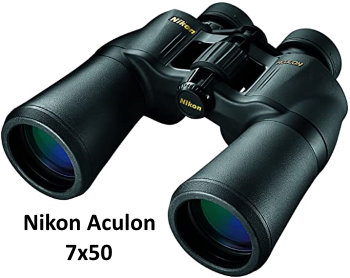
Nikon Aculon Features:
- Aspherical Multicoated Eco-Glass Lenses
- BaK-4 Porro Prism Glass for bright, clear images
- Smooth central focus knob
- Easy-positioning turn and slide rubber eyecups
- Lightweight for its size: 31.9 ounces
The Nikon Action EX (Extreme) 7x50 Binoculars are also a good choice in the $150 range if you want a pair that are waterproof and fogproof.
Steiner 7x50 Binoculars (Under $300 with other Steiner options up to $450+ and $1300+)
The Steiner 7x50 Binoculars are marketed as marine binoculars, but are excellent multipurpose binoculars for birdwatching, astronomy, and more.
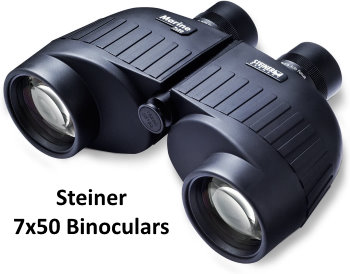
Steiner Binocular Features:
- Sports Auto Focus - set to your eyes, everything in focus from 20 yards to infinity
- Wide Field of View - 356 ft
- Floating silicone prism system prevents damage from absorbing shock, drops, impacts, etc..
- Waterproof and rubber armored
- Weight - 36.3 oz.
If you need 7x50 Marine Binoculars with a reticle, compass, submersion protection, then Steiner makes the following models with those features and more:
Steiner Navigator Pro 7x50 ($450+) - Compass options, Makralon housing, N2 injection, submersible up to 16 ft
Steiner Commander 7x50 ($1,300+) - Digitial compass, precision reticle, Makralon housing, N2 injection, submersible up to 33 ft
You can read our detailed review of all the Steiner models on our Best Marine Binoculars page.
Lightweight Celestron Cometron 7x50 Binoculars (Under $40)
The Celestron Cometron 7x50 Binoculars are cheap porro prism binoculars ($30+) that I wouldn't recommend for beginner birders, but may be acceptable for casual stargazing and backyard birdwatching or birding that doesn't require a lot of detail for identification.
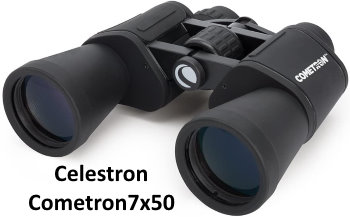
Celestron Cometron Features:
- Very lightweight for 7x50 binoculars - only 27 oz.!
- Wide Field of View - 357 ft
- Large exit pupil - 7mm
Lens and prism quality goes down in this cheaper range.
The Cometron has BK-7 prism glass instead of the higher quality BaK-4 glass. Where you'll notice this is distortion around the edges of the lenses.
For example, blurring will occur near the edges of focus so details on field marks of birds won't be as clear, or when star gazing, stars near the edges of the lenses will appear more as blurs (don't mistake them as galaxies ;-) ) instead of as clear pinpoints.
However, even though the Celestrons are cheap binoculars they are surprisingly good as an an entry level binocular.
Get the Cometron only if your budget doesn't allow for anything in the $100+ range.
You can view more reviews here on our Best Cheap Binoculars page.
7x50 Binoculars FAQs
How far can you see with 7x50 binoculars? Are they any good?
7x50 binoculars have a 7x magnification with a 50mm objective lens.
A 7x binocular will be easier to hold steady than an 8x or 10x binocular which with increased magnification will also increase the shaking of hands when viewing through the lenses.
Dividing the objective lens by the magnification equals the exit pupil size.
So for 7x50 binoculars, 50/7 equals an exit pupil size of 7mm.
This is excellent for allowing more light to reach your eyes and viewing images. We recommend an exit pupil of 4mm or more, so 7mm is ideal.
Why is a large objective lens size good to have?
The larger the objective lens, the more light is gathered into the lenses, which results in a brighter image, which is especially good in low light conditions such as at dawn and dusk or cloudy days.
The larger objective lens also will provide a larger field of view (FOV), especially when paired with a lower magnification such as a 7x, which will allow you to locate and find objects (wildlife, stars, marine objects, etc..) while scanning with your binoculars.
As magnification goes up, field of view decreases.
So 8x50 and 10x50 binoculars have greater magnification, but a narrower field of view.
The only downside to having a larger objective lens size is its weight and larger size.
A 50mm lens in a 7x50 binocular will obviously weigh more than a 7x35 binocular.
But if you don't need your binoculars to be compact or lightweight, then the larger 50mm lens with it's wider FOV and increased light gathering capacity is a good choice.
What is better - 7x50 or 10x50 Binoculars?
If you need more magnification for detail in identification or viewing wildlife/objects at a far distance, then get 10x50 binoculars.
What you will sacrifice in the 10x50s vs 7x50s is a narrower field of view and less light gathering capacity.
Best 10x50 Binoculars
Try either the Nikon Monarch 10x50 Binoculars (mid-priced) or
Nikon Action 10x50 Binoculars (budget priced) which are both excellent for this magnification and objective lens size.
The Nikon Monarchs are more expensive as roof prism binoculars vs porro prism in the Nikon Action models, but both are very good binoculars in both price ranges.
Also take a look at our Best 10x50 Binocular Reviews page for our top 3 picks.
Related Binocular Pages
Best Binoculars for Bird Watching - in 4 price ranges
How to Choose Binoculars - What features to look for according to your needs
|
Our Favorite Bird Watching Binoculars, Squirrel-Proof Feeder & Hummingbird Feeder Read Our Reviews: |
||
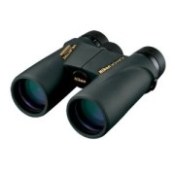
Nikon Monarch M5
Best mid-priced bird watching binoculars. Waterproof, shockproof, multi-coated ED-Glass. |
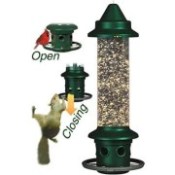
|
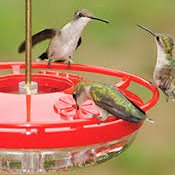
Best Hummingbird Feeder
Drip-Free, Ant-moat, Durable, Easy to Fill and Clean. |
| Click Images or Links To View More Info | ||